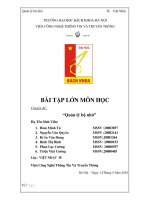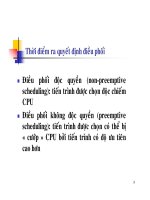Bài tập lớn :quản lý tiến trình android
Bạn đang xem bản rút gọn của tài liệu. Xem và tải ngay bản đầy đủ của tài liệu tại đây (215.37 KB, 16 trang )
ANDROI
D
PROCESS MANAGEMENT
BY
HOANG VAN KIEN
HOANG HUY KHANH
PHUNG DUC LUAN
ANDROID
APPLICATION FUNDAMENTALS
PROCESS LIFE CYCLE
Application Fundamentals
04:52:53
PM
Application Components
Android
Android is
is multi-user
multi-user OS,
OS, each
each application
application
has
has it’s
it’s own
own user
user ID
ID
(because
(because of
of security
security reasons).
reasons).
Each
Each application
application has
has it’s
it’s own
own VM(virtual
VM(virtual
machine),
machine), to
to provide
provide isolation
isolation from
from other
other
process.
process.
Each
Each application
application has
has it’s
it’s own
own process.
process.
Application
Application is
is aa combination
combination of
of
components.
components.
APPLICATION
PROCESS
COMPONENT
COMPONENT
COMPONENT
COMPONENT
Application Fundamentals
04:52:53
PM
Application Components
Activities
An activity represents a single
screen with a user interface,
in-short Activity performs
action on the screen.
Services
A service is a component that
runs in the background to
perform long-running
operations.
A
S
B
C
A
Broadcast Receivers
Broadcast receivers simply
respond to broadcast messages
from other applications or from
the system.
Content Providers
A content provider component
supplies data from one
application to others on request.
Other Components
There are additional
components which will be used
in the construction of above
mentioned entities.
Application Fundamentals
04:52:53
PM
Application Components
First Activity
Second Activity
Click me!
This is second
activity
Application Fundamentals
04:52:53
PM
Application Components
Your
Your app
app can
can use
use another
another app’s
app’s components
components
YOUR APP
Use Email app to write
Write Email
Get Email Address
Use Contacts app to
get email address
Send Email
Use Email app to send
Application Fundamentals
04:52:53
PM
Activity Stack
Activity Stack
Activity 1
Previous Activities
Removed to
free resources
Activity 2
…
Activity 3
Activity n-1
Last Running Activity
Back button pushed or
Running activity closed
New Activity Started
New Activity
Running Activity
Application Fundamentals
04:52:53
PM
Activity Lifecycle
New Activity
1. onCreated()
4 states of an activity.
2. onStart()
3. onResume()
1.Active/Running: if the activity is at the
foreground.
2.Paused: if the activity is at the background
and still visible.
3.Stopped: if the activity is not visible and
therefore is hidden or obscured by another
activity.
4.Destroyed: when the activity process is killed
or completed terminated.
Running
onResume()
onPause()
Paused
3. onResume()
2. onStart()
<<kill>>
onStop()
1. onRestart()
Stopped
onDestroy()
Destroyed
<<kill>>
Application Fundamentals
04:52:53
PM
Activity Lifecycle
There are 7 lifecycle processes in an Android
activity. They include −
onCreate − It is called when the activity is first
created.
onStart − It is called when the activity starts
and becomes visible to the user.
onResume − It is called when the activity starts
interacting with the user. User input takes place
at this stage.
onPause − It is called when the activity runs in
the background but has not yet been killed.
onStop − It is called when the activity is no
longer visible to the user.
onRestart − It is called after the activity has
stopped, before starting again. It is normally
called when a user goes back to a previous
activity that had been stopped.
onDestroy − This is the final call before the
activity is removed from the memory.
New Activity
1. onCreated()
2. onStart()
3. onResume()
Running
onResume()
onPause()
Paused
3. onResume()
2. onStart()
<<kill>>
onStop()
1. onRestart()
Stopped
onDestroy()
Destroyed
<<kill>>
Android Process Lifecycle
04:52:53
PM
Android Process
For
For each
each application
application android
android creates
creates aa
new
new process
process with
with single
single thread
thread of
of
execution(i.e
execution(i.e main
main thread)
thread)
By
By default
default all
all the
the components
components run
run in
in
same
same thread(main
thread(main thread).
thread).
In
In low
low memory
memory situations
situations aa process
process is
is
decide
decide to
to kill
kill based
based upon
upon the
the number
number of
of
inactive
inactive components
components of
of that
that process.
process.
AA process
process which
which have
have more
more number
number of
of
inactive
inactive components
components should
should be
be killed
killed
first.
first.
APPLICATION
PROCESS
THREAD
COMPONENT
COMPONENT
COMPONENT
COMPONENT
Android Process Lifecycle
04:52:53
PM
Android Process States
Process Priority
1.Active Process
Active (foreground) processes have application
components the user is interacting with:
• Activities in an active state
• Broadcast Receivers executing onReceive
• Services executing onStart, onCreate
• Running Services that have been flagged to run in
the foreground
Active Process
Highest
Visible Process
Service Process
Background Process
Empty Process
Lowest
Android Process Lifecycle
04:52:53
PM
Android Process States
Process Priority
2. Visible Process
Visible but inactive processes are those hosting
“visible” Activities. This happens when an Activity is
only partially obscured (by a non-full-screen or
transparent Activity).
Active Process
Highest
Visible Process
Service Process
Background Process
Empty Process
Lowest
Android Process Lifecycle
04:52:53
PM
Android Process States
Process Priority
3. Service Process
Processes hosting Services that have been started.
Because these Services don’t interact directly with
the user, they receive the same priority with visible
process.
Active Process
Highest
Visible Process
Service Process
Background Process
Empty Process
Lowest
Android Process Lifecycle
04:52:53
PM
Android Process States
Process Priority
4. Background Process
Processes hosting Activities that aren’t visible and
that don’t have any running Services. There will
generally be a large number of background processes
that Android will kill using a last-seen-first-killed
pattern in order to obtain resources for foreground
processes.
Active Process
Highest
Visible Process
Service Process
Background Process
Empty Process
Lowest
Android Process Lifecycle
04:52:53
PM
Android Process States
Process Priority
5. Empty Process
To improve overall system performance, Android will
often retain an application in memory after it has
reached the end of its lifetime. Android maintains this
cache to improve the start-up time of applications
when they’re re-launched.
These processes are routinely killed, as required.
Active Process
Highest
Visible Process
Service Process
Background Process
Empty Process
Lowest
THANKS FOR LISTENING!









